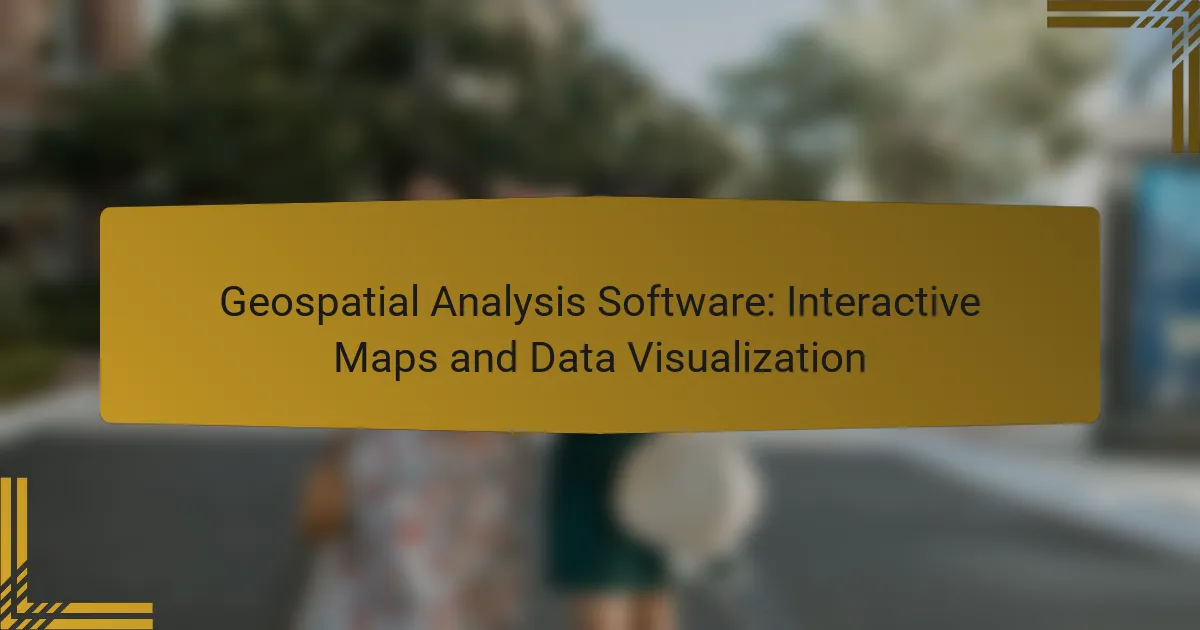Geospatial analysis software plays a crucial role in transforming complex spatial data into interactive maps and insightful visualizations. By offering a range of tools tailored for various needs, these platforms enhance data interpretation and facilitate the identification of patterns. Users can leverage features such as layering, geocoding, and data filtering to create engaging and informative visual representations of their data.
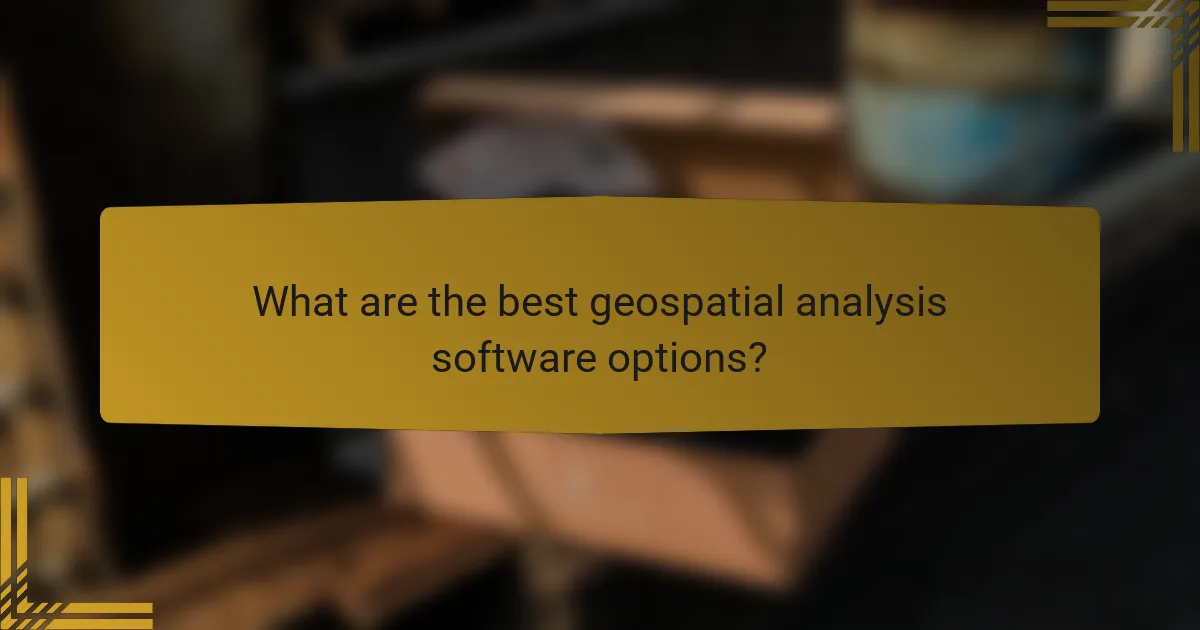
What are the best geospatial analysis software options?
The best geospatial analysis software options include a variety of tools that cater to different needs, from professional-grade platforms to open-source solutions. Key considerations include ease of use, data integration capabilities, and the specific features required for your projects.
ArcGIS Online
ArcGIS Online is a cloud-based mapping and analysis tool that allows users to create interactive maps and visualize data effectively. It provides a comprehensive suite of tools for spatial analysis, data management, and collaboration.
Users can leverage its extensive library of basemaps and ready-to-use data layers, making it suitable for both beginners and advanced users. Subscription costs vary based on the features and user count, typically starting from a few hundred USD per year.
QGIS
QGIS is a powerful open-source geographic information system that enables users to analyze and visualize spatial data. It supports a wide range of file formats and integrates well with other data sources.
This software is highly customizable, allowing users to create tailored plugins and scripts. Being free to use, it is an excellent choice for individuals and organizations with limited budgets, although it may require a steeper learning curve for new users.
Mapbox
Mapbox is a versatile platform for building custom maps and visualizations, focusing on web and mobile applications. It offers a range of APIs and SDKs that allow developers to create interactive maps with high-quality visuals.
Pricing for Mapbox is usage-based, making it affordable for small projects but potentially costly for high-traffic applications. Its flexibility and design capabilities make it popular among developers and designers alike.
Tableau
Tableau is primarily a data visualization tool that also supports geospatial analysis through its mapping capabilities. It allows users to create interactive dashboards that incorporate geographic data alongside other metrics.
Tableau’s drag-and-drop interface makes it user-friendly, but it requires a subscription, with costs typically starting in the low thousands of USD per year. It’s ideal for businesses looking to integrate spatial insights into broader data analysis.
Google Earth Pro
Google Earth Pro is a free tool that provides users with the ability to explore and visualize geographic data in 3D. It is particularly useful for viewing satellite imagery and creating simple maps.
While it lacks some advanced analytical features found in other software, its ease of use and accessibility make it a great starting point for individuals or small organizations interested in geospatial analysis without significant investment.
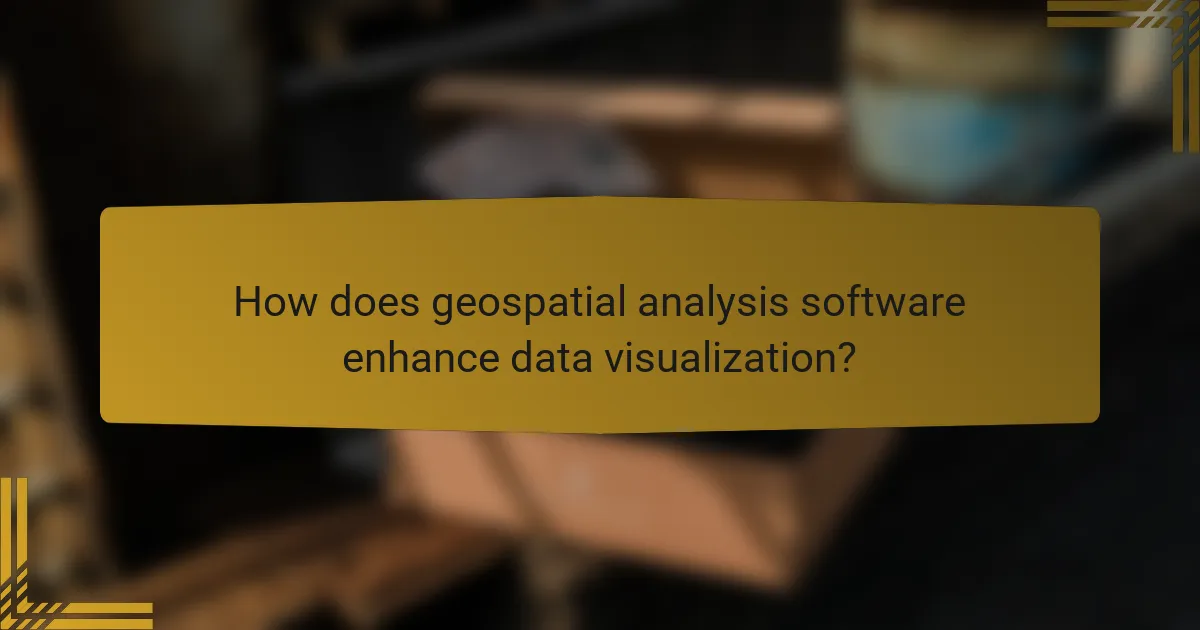
How does geospatial analysis software enhance data visualization?
Geospatial analysis software significantly enhances data visualization by providing tools that allow users to create interactive maps and analyze spatial data effectively. These tools enable users to visualize complex datasets in a more intuitive manner, making it easier to identify patterns and insights.
Interactive mapping features
Interactive mapping features allow users to engage with data visually by zooming, panning, and clicking on various elements within a map. This interactivity helps users explore geographic information dynamically, revealing details that static maps cannot convey.
Common features include layer toggling, where users can switch between different data sets, and tooltips that provide additional information on hover. For instance, a user might click on a city to see demographic data or historical trends, enhancing their understanding of the area.
Real-time data integration
Real-time data integration allows geospatial analysis software to pull in live data feeds, making visualizations current and relevant. This capability is crucial for applications such as tracking weather patterns, traffic conditions, or emergency response situations.
Users should consider the source and reliability of real-time data. Integrating data from trusted sources can significantly improve the accuracy of visualizations, while unreliable data can lead to misleading conclusions. For example, using real-time traffic data from a reputable service can help city planners make informed decisions about infrastructure improvements.
Customizable dashboards
Customizable dashboards enable users to tailor their data visualization experience according to specific needs and preferences. Users can select which metrics to display, adjust layouts, and choose visual styles that best represent their data.
Effective dashboards often include a mix of charts, maps, and tables, allowing users to see different aspects of the data at a glance. For instance, a dashboard for a retail chain might show sales performance by region on a map while displaying inventory levels in a table, facilitating quick decision-making.

What are the key features of interactive maps?
Interactive maps are dynamic tools that allow users to visualize and manipulate geospatial data effectively. Key features include layering capabilities, geocoding and routing functionalities, and data filtering options, all of which enhance user engagement and data analysis.
Layering capabilities
Layering capabilities enable users to overlay multiple data sets on a single map, providing a comprehensive view of various geographic elements. This feature allows for the visualization of different types of information, such as demographic data, environmental factors, or infrastructure details, all at once.
When using layering, consider the clarity of your map. Too many layers can lead to confusion, so it’s often best to limit layers to the most relevant data. For instance, a city planning map might effectively combine zoning information with transportation routes.
Geocoding and routing
Geocoding transforms addresses into geographic coordinates, allowing users to pinpoint locations on a map. Routing features then calculate optimal paths between these points, which is essential for applications like delivery services or travel planning.
To utilize geocoding effectively, ensure your data is accurate and formatted correctly. Many software solutions offer batch geocoding, which can process multiple addresses simultaneously, saving time and effort. For routing, consider factors such as traffic conditions and road types to provide the best routes.
Data filtering options
Data filtering options allow users to refine the information displayed on interactive maps based on specific criteria. This feature is crucial for focusing on particular datasets, such as filtering by date, category, or geographic area.
Implementing effective data filters can enhance user experience by making it easier to find relevant information. For example, a real estate map might allow users to filter properties by price range, number of bedrooms, or proximity to schools. Always ensure that filters are intuitive and clearly labeled to avoid user frustration.
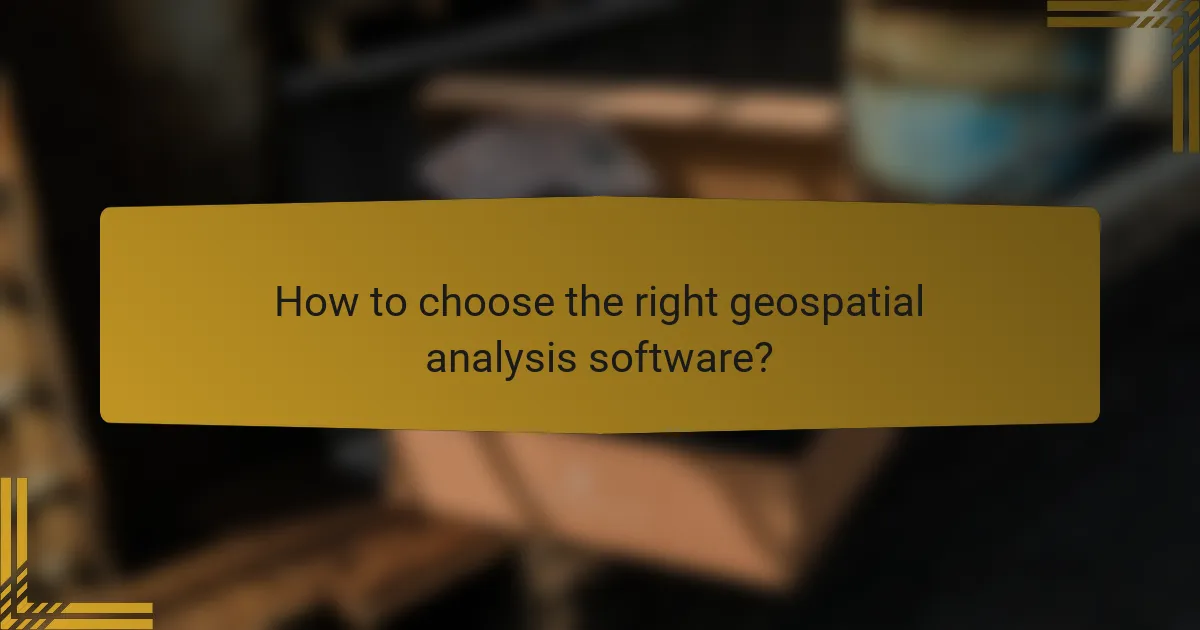
How to choose the right geospatial analysis software?
Choosing the right geospatial analysis software involves understanding your specific needs, the software’s integration capabilities, and its pricing structure. A well-suited tool can enhance your data visualization and interactive mapping efforts significantly.
Assessing user needs
Begin by identifying the primary tasks you need the software to perform, such as data visualization, spatial analysis, or real-time mapping. Consider the skill level of the intended users; some software may require advanced technical knowledge while others cater to beginners.
Gather input from potential users to understand their requirements. This can include features like user-friendly interfaces, customization options, and the ability to handle large datasets. Prioritize these needs to find software that aligns closely with your objectives.
Evaluating integration capabilities
Integration capabilities are crucial for ensuring that the geospatial software works seamlessly with your existing systems. Check if the software can connect with databases, GIS tools, or other data sources you currently use.
Look for software that supports common data formats and APIs. This flexibility can save time and reduce the complexity of data management. A well-integrated system can enhance workflow efficiency and improve data accuracy.
Comparing pricing models
Pricing models for geospatial analysis software can vary widely, including one-time purchases, subscriptions, or pay-per-use options. Assess your budget and consider the total cost of ownership, which includes maintenance and support fees.
Some software may offer tiered pricing based on features or user numbers, while others might provide free trials or basic versions. Evaluate these options to find a solution that meets your financial constraints while still fulfilling your analytical needs.
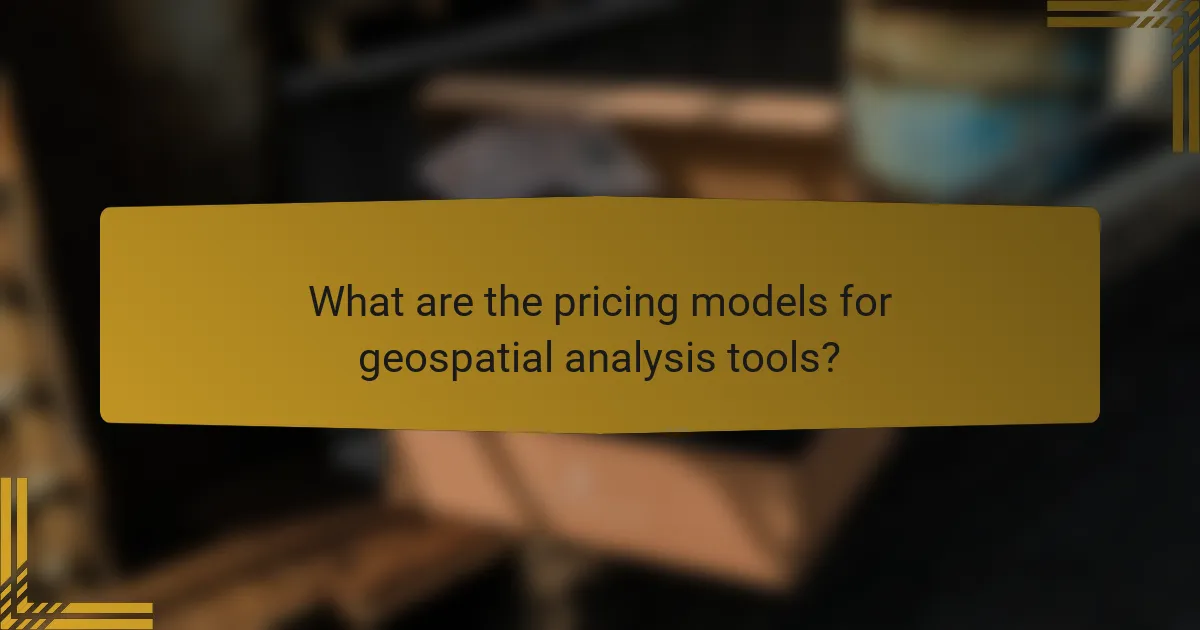
What are the pricing models for geospatial analysis tools?
Geospatial analysis tools typically offer various pricing models to accommodate different user needs and budgets. The most common models include subscription-based pricing, one-time purchase options, and freemium models, each with distinct advantages and considerations.
Subscription-based pricing
Subscription-based pricing is a popular model for geospatial analysis software, often billed monthly or annually. This approach allows users to access the latest features and updates without a large upfront investment, making it suitable for businesses that require flexibility.
Costs can vary widely, typically ranging from a few dozen to several hundred USD per month, depending on the software’s capabilities and the number of users. It’s essential to evaluate whether the subscription includes support and training, as these can significantly enhance the value of the investment.
One-time purchase options
One-time purchase options involve a single upfront payment for perpetual access to the software. This model can be appealing for organizations that prefer to avoid ongoing fees and have predictable budgeting.
Prices for one-time purchases can range from a few hundred to several thousand USD, depending on the software’s complexity and features. However, users should consider potential costs for future upgrades and maintenance, which may not be included in the initial purchase.
Freemium models
Freemium models provide basic access to geospatial analysis tools at no cost, with the option to upgrade to premium features for a fee. This model is advantageous for individuals or small organizations looking to explore capabilities without financial commitment.
While freemium versions can be limited in functionality, they often serve as a good introduction to the software. Users should be aware of the potential costs associated with upgrading to access advanced features, which can vary significantly based on the provider.
